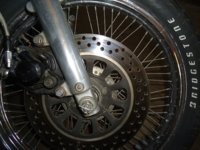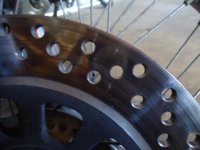plattey
XS650 Addict
So I drilled my front brake rotor on my '82 hoping to save some weight and in order to get the holes to overlap when the pad swept by, the hole diameter was increased to 3/8". Let's just say that the disc is much lighter now but the braking power compared to before is no-where at the same level as before with the stock disc. The pattern I used was pretty aggressive and I'm afraid that I removed too much surface area. The setup lacks the initial "bite" as it did before. I'm using the stock replacement pads from Mikes and ss braided line with a rebuilt stock master cylinder.


 My bad, here are some pictures:
My bad, here are some pictures:
